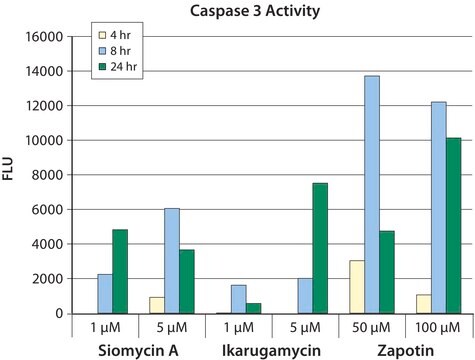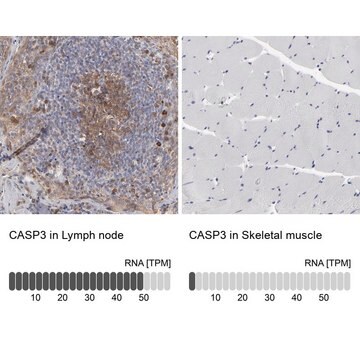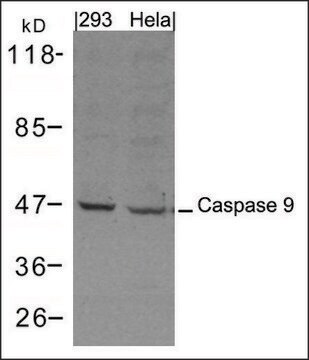추천 제품
생물학적 소스
rabbit
결합
unconjugated
항체 형태
IgG fraction of antiserum
항체 생산 유형
primary antibodies
클론
polyclonal
형태
buffered aqueous solution
분자량
antigen 32 kDa
종 반응성
human
기술
microarray: suitable
western blot: 1:3,000 using Jurkat human T-cell leukemia cell extract
UniProt 수납 번호
배송 상태
dry ice
저장 온도
−20°C
타겟 번역 후 변형
unmodified
유전자 정보
human ... CASP3(836)
일반 설명
Caspase 3 is a cytosolic protein present as a 32 kDa proenzyme in cells. It is activated by proteolytic cleavage into the 20 kDa (p20) and 11 kDa (p11) active subunits when cells undergo apoptosis.
면역원
synthetic peptide corresponding to the N-terminal of human caspase 3 (amino acids 29-43 with C-terminally added lysine) conjugated to KLH. This sequence, unique to caspase 3, corresponds to N-terminal of the enzyme p20 subunit and is highly conserved in rat and mouse caspase 3.
애플리케이션
Anti-Caspase 3 antibody produced in rabbit is suitable for microarray and western blotting at a working dilution of 1:3000 using Jurkat human T-cell leukemia cell extract. It was used as a primary antibody for western blotting in a study to establish the biomolecular basis for the role of PCMT1 (isoaspartyl protein carboxyl-O-methyltransferase) as a part of a novel apoptosis regulatory mechanism. It was used to examine activation of caspase-3 via immunoblotting in a study to confirm the apoptosis of tumor cells mediated by AAV-ISN-T (recombinant adeno-associated virus vector with signal peptides of human insulin) administration. It was used as a primary antibody at 1:300 dilution for immunohistochemistry of deparaffinized sections of squamous cell carcinoma of the tongue containing surrounding normal tissue. It was used at a dilution of 1:1000 to detect caspase-3 and its cleaved form P20 in a study.
생화학적/생리학적 작용
Caspase 3 cleaves many key proteins including poly(ADP-ribose) polymerase (PARP), sterol-regulatory element-binding proteins (SREBPs), DNA-dependent protein kinase (DNA-PK), α-fodrin, gelsolin, PKCd and DFF45/ICAD during apoptosis. High levels of this enzyme in lymphocytes suggest that it is an important mediator of apoptosis in the immune system. Deletion of CASP-3 gene in mice results in hyperplasia and cell abnormalities, indicating that caspase 3 is essential for morphogenetic cell death during normal brain development.
Caspase 3 is one of the key executioners of apoptosis downstream in the apoptotic pathway, as it is activated in cells by various death signals. In some neurodegenerative diseases, such as Huntington disease (HD) and Alzheimer′s disease (AD), specific neuronal caspase substrates have been identified. In Huntington disease (HD), caspase 3 specifically cleaves the HD gene product, Huntingtin.
물리적 형태
Solution in 0.01 M phosphate buffered saline, pH 7.4, containing 15 mM sodium azide.
면책조항
Unless otherwise stated in our catalog or other company documentation accompanying the product(s), our products are intended for research use only and are not to be used for any other purpose, which includes but is not limited to, unauthorized commercial uses, in vitro diagnostic uses, ex vivo or in vivo therapeutic uses or any type of consumption or application to humans or animals.
적합한 제품을 찾을 수 없으신가요?
당사의 제품 선택기 도구.을(를) 시도해 보세요.
Storage Class Code
10 - Combustible liquids
WGK
nwg
Flash Point (°F)
Not applicable
Flash Point (°C)
Not applicable
시험 성적서(COA)
제품의 로트/배치 번호를 입력하여 시험 성적서(COA)을 검색하십시오. 로트 및 배치 번호는 제품 라벨에 있는 ‘로트’ 또는 ‘배치’라는 용어 뒤에서 찾을 수 있습니다.
이미 열람한 고객
Alterations in Gene Expression Associated with Head and Neck Squamous Cell Carcinoma Development.
Serewko-Auret, Magdalena M
Cancer, Genomics, and Proteomics, 1, 137-148 (2004)
Apoptosis: a review of programmed cell death.
Elmore S.
Toxicologic Pathology, 35(4), 495-516 (2007)
Huntingtin inhibits caspase-3 activation.
Zhang Y, et al.
The Embo Journal, 25(24), 5896-5906 (2006)
Q Song et al.
The EMBO journal, 15(13), 3238-3246 (1996-07-01)
Radiosensitive cell lines derived from X-ray cross complementing group 5 (XRCC5), SCID mice and a human glioma cell line lack components of the DNA-dependent protein kinase, DNA-PK, suggesting that DNA-PK plays an important role in DNA double-strand break repair. Another
Hong Ma et al.
Hepatology (Baltimore, Md.), 42(6), 1355-1363 (2005-12-01)
The extracellular domain of the tumor necrosis factor-related apoptosis-inducing ligand (sTRAIL) may function as a soluble cytokine to selectively kill various cancer cells without toxicity to most normal cells. We constructed a series of recombinant adeno-associated virus (AAV) vectors expressing
자사의 과학자팀은 생명 과학, 재료 과학, 화학 합성, 크로마토그래피, 분석 및 기타 많은 영역을 포함한 모든 과학 분야에 경험이 있습니다..
고객지원팀으로 연락바랍니다.













